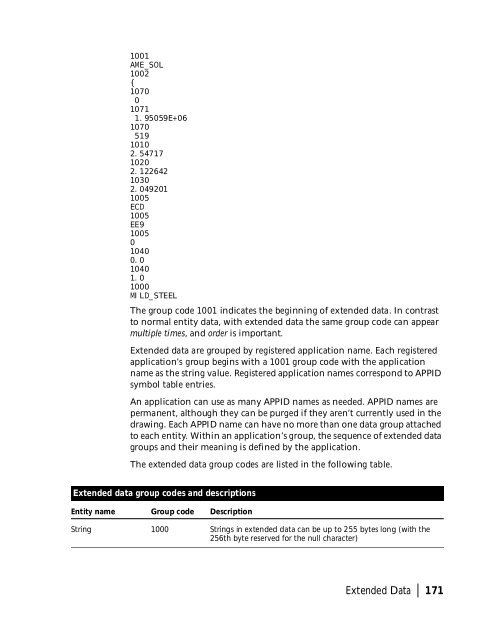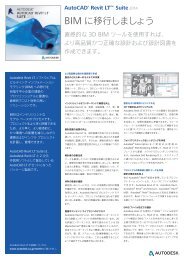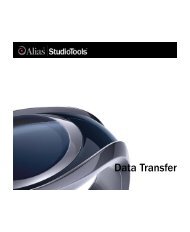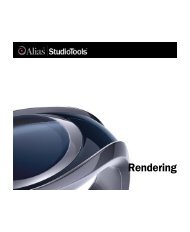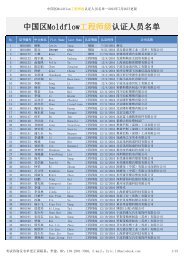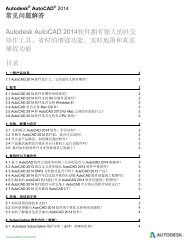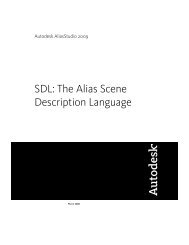- Page 1 and 2:
AutoCAD ® 2002 DXF Reference Guide
- Page 3 and 4:
Contents Revisions to the DXF Refer
- Page 5 and 6:
LWPOLYLINE . . . . . . . . . . . .
- Page 7 and 8:
Revisions to the DXF Reference This
- Page 9:
Objects Section | 3
- Page 12 and 13:
Organization of This Reference The
- Page 14 and 15:
Group code value types (continued)
- Page 16 and 17:
Group codes by number (continued) G
- Page 18 and 19:
Group codes by number (continued) G
- Page 20 and 21:
Group codes by number (continued) G
- Page 22 and 23:
HEADER Section Group Codes The foll
- Page 24 and 25:
DXF system variables (continued) Va
- Page 26 and 27:
DXF system variables (continued) Va
- Page 28 and 29:
DXF system variables (continued) Va
- Page 30 and 31:
DXF system variables (continued) Va
- Page 32 and 33:
DXF system variables (continued) Va
- Page 34 and 35:
the values in the VPORT table entri
- Page 37 and 38:
CLASSES Section 3 The group codes d
- Page 39 and 40:
Default Class Values AutoCAD regist
- Page 41 and 42:
TABLES Section 4 The group codes de
- Page 43 and 44:
Group codes that apply to all symbo
- Page 45 and 46:
APPID group codes Group codes Descr
- Page 47 and 48:
DIMSTYLE group codes (continued) Gr
- Page 49 and 50:
DIMSTYLE group codes (continued) Gr
- Page 51 and 52:
LTYPE The following group codes app
- Page 53 and 54:
STYLE group codes (continued) Group
- Page 55 and 56:
Each 71/13,23,33 pair defines the U
- Page 57 and 58:
VIEW with UCS group codes Group cod
- Page 59 and 60:
VPORT group codes (continued) Group
- Page 61 and 62:
BLOCKS Section 5 The group codes de
- Page 63 and 64:
Block group codes (continued) Group
- Page 65 and 66:
ENTITIES Section 6 This chapter pre
- Page 67 and 68:
Group codes that apply to all graph
- Page 69 and 70:
3DSOLID The following group codes a
- Page 71 and 72:
Arc group codes (continued) Group c
- Page 73 and 74:
page 60. For information about abbr
- Page 75 and 76:
CIRCLE The following group codes ap
- Page 77 and 78:
Common dimension group codes (conti
- Page 79 and 80:
and formatting used in this table,
- Page 81 and 82:
Angular dimension group codes (cont
- Page 83 and 84:
For information about abbreviations
- Page 85 and 86:
For information about abbreviations
- Page 87 and 88:
Hatch boundary path data group code
- Page 89 and 90:
Spline edge data group codes (conti
- Page 91 and 92:
Image group codes (continued) Group
- Page 93 and 94:
Leader group codes (continued) Grou
- Page 95 and 96:
Lwpolyline group codes Group codes
- Page 97 and 98:
Mline group codes (continued) Group
- Page 99 and 100:
Mtext group codes (continued) Group
- Page 101 and 102:
Ole2frame group codes (continued) G
- Page 103 and 104:
POLYLINE The following group codes
- Page 105 and 106:
ordering. Programs that generate po
- Page 107 and 108:
Shape group codes (continued) Group
- Page 109 and 110:
Spline group codes (continued) Grou
- Page 111 and 112:
Text group codes (continued) Group
- Page 113 and 114:
Trace group codes (continued) Group
- Page 115 and 116:
VIEWPORT index is negative, the edg
- Page 117 and 118:
Viewport group codes (continued) Gr
- Page 119 and 120:
XLINE The following group codes app
- Page 121 and 122:
OBJECTS Section 7 This chapter pres
- Page 123 and 124:
Common object group codes Group cod
- Page 125 and 126: ACDBDICTIONARYWDFLT group codes Gro
- Page 127 and 128: DICTIONARY group codes (continued)
- Page 129 and 130: DIMASSOC group codes (continued) Gr
- Page 131 and 132: IDBUFFER The following group codes
- Page 133 and 134: IMAGEDEF_REACTOR group codes Group
- Page 135 and 136: LAYOUT group codes (continued) Grou
- Page 137 and 138: MLINESTYLE The following group code
- Page 139 and 140: OBJECT_PTR group codes (continued)
- Page 141 and 142: PLOTSETTINGS group codes (continued
- Page 143 and 144: SPATIAL_INDEX group codes (continue
- Page 145 and 146: SORTENTSTABLE group codes Group cod
- Page 147 and 148: Xrecord group codes Group codes Des
- Page 149 and 150: THUMBNAILIMAGE Section 8 This chapt
- Page 151 and 152: Drawing Interchange File Formats A
- Page 153 and 154: ■ ■ ■ ■ VIEW (view table) V
- Page 155 and 156: Symbol Table Group Codes in DXF Fil
- Page 157 and 158: 0 STYLE Second entry begins. No xda
- Page 159 and 160: Entity Group Codes in DXF Files The
- Page 161 and 162: ' ReadDXF extracts specified code/v
- Page 163 and 164: The following Visual Basic subrouti
- Page 165 and 166: Slide Files The type of data follow
- Page 167 and 168: Slide file data records (continued)
- Page 169 and 170: Old slide file header (continued) F
- Page 171 and 172: Advanced DXF Issues B This appendix
- Page 173 and 174: NOTE If you use 1005 xdata group co
- Page 175: 999 FOOGRANDCHILD, defined by class
- Page 179 and 180: Extended data group codes and descr
- Page 181 and 182: Arbitrary Axis Algorithm The arbitr
- Page 183 and 184: Index *Model_Space block definition
- Page 185 and 186: DIMTIH DXF system variable, 20 DIMT
- Page 187 and 188: pointer references vs. ownership re


